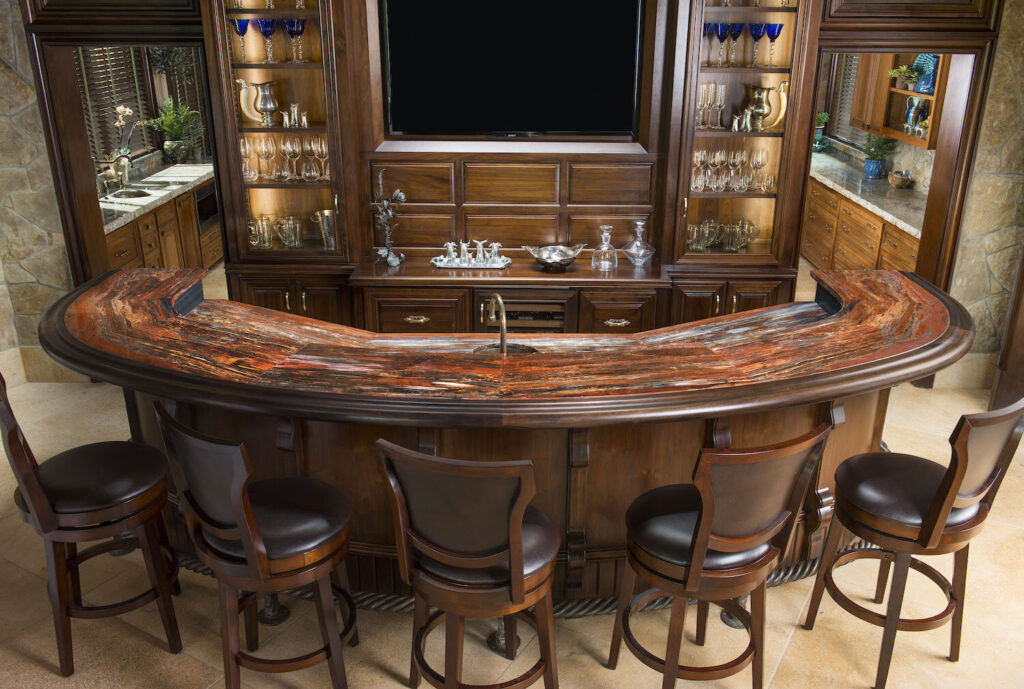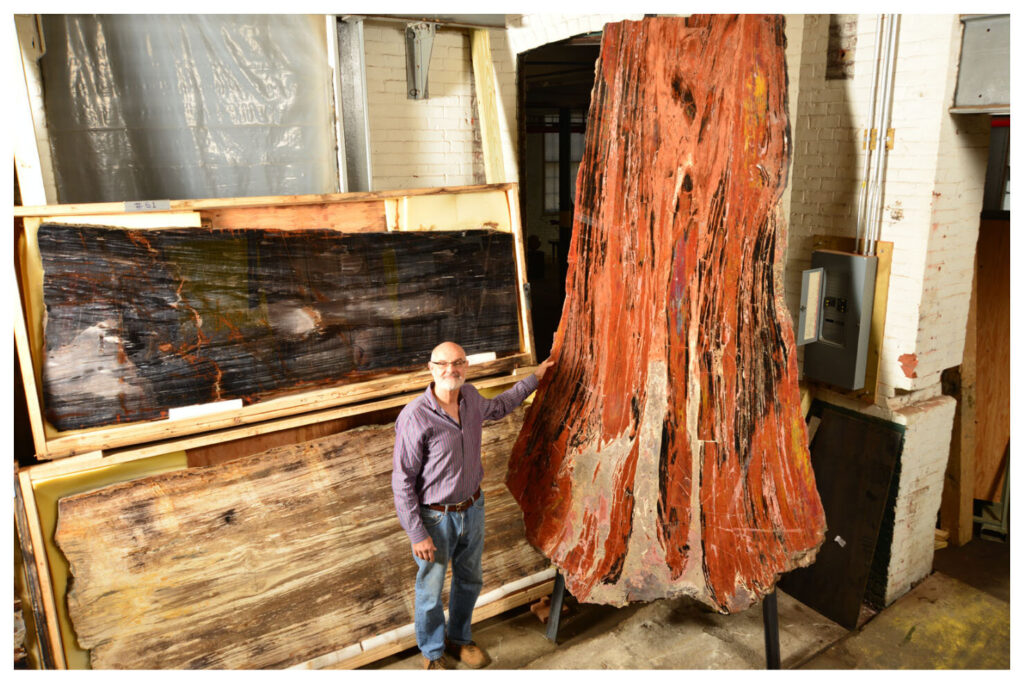Understanding Petrified Wood: A Natural Wonder
Petrified wood, a fascinating and beautiful natural artifact, has captivated collectors and enthusiasts for centuries. Formed over millions of years, petrified wood originates from ancient trees that underwent a unique fossilization process. Minerals such as silica replaced the organic material of the wood, creating stunning stone replicas of the original trees. This process preserves the intricate details of the wood, showcasing striking colors and patterns that vary depending on the mineral composition.
The Appeal of Petrified Wood: Beauty and History Combined
Petrified wood is more than just a beautiful decoration; it is a piece of history frozen in time. Each piece tells a story of ancient forests and the passage of geological epochs. Collectors and interior designers prize petrified wood for its aesthetic appeal and historical significance. Whether displayed as a table, sculpture, or decorative item, petrified wood adds a unique touch of natural beauty to any space.
Factors to Consider When Buying Petrified Wood
When purchasing petrified wood, several factors must be considered to ensure you acquire a high-quality piece that suits your needs and preferences. Here are the essential aspects to keep in mind:
1. Authenticity and Source
Ensure that the petrified wood you buy is genuine. Authentic petrified wood comes from reputable sources and is often accompanied by certification. Verify the origin of the piece and inquire about its geological history. Avoid synthetic imitations or pieces that lack clear provenance.
2. Quality and Condition
Examine the quality and condition of the petrified wood. High-quality pieces have vivid colors, well-preserved details, and minimal cracks or imperfections. Inspect the piece for any signs of repair or enhancement, which could affect its value and appearance.
3. Size and Weight
Consider the size and weight of the petrified wood piece, especially if you plan to display it as a piece of furniture or large decoration. Petrified wood can be heavy and challenging to move, so ensure you have adequate space and support for the item.
4. Color and Pattern
One of the most appealing aspects of petrified wood is its variety of colors and patterns. The mineral composition during fossilization affects the hues and designs found in the wood. Choose a piece that complements your aesthetic preferences and fits well with your interior design.

Where to Buy Petrified Wood
Petrified wood can be purchased from various sources, including specialized online retailers, antique shops, and geological museums. Here are some reputable options:
1. Online Retailers
Many online platforms offer a wide selection of petrified wood pieces. Websites like Russell Zuhl provide detailed descriptions, images, and certifications to help you make an informed purchase. Ensure the retailer has positive reviews and a good reputation in the market.
2. Antique Shops and Auctions
Antique shops and auctions often have unique and rare pieces of petrified wood. These venues allow you to see the items in person and verify their authenticity. Auctions can also offer competitive prices, but be prepared to research and bid accordingly.
3. Geological Museums and Specialty Stores
Geological museums and specialty stores dedicated to fossils and minerals are excellent places to find high-quality petrified wood. These establishments often have knowledgeable staff who can provide insights into the history and significance of the pieces they sell.
Caring for Petrified Wood
To maintain the beauty and longevity of your petrified wood, proper care is essential. Here are some tips for preserving your piece:
1. Cleaning
Clean your petrified wood with a soft, dry cloth to remove dust and debris. Avoid using water or harsh chemicals, as they can damage the surface and affect the wood’s natural appearance.
2. Placement
Place your petrified wood in a location where it is not exposed to direct sunlight or extreme temperatures. Prolonged exposure to sunlight can cause colors to fade, while temperature fluctuations can lead to cracks or other damage.
3. Protection
Use protective pads or coasters if you plan to use your petrified wood as a functional item, such as a table. This will prevent scratches and other surface damage. For display pieces, consider using a glass case or stand to protect the wood from dust and accidental impacts.
Valuing Petrified Wood at Russell-Zuhl
With over 50 years of experience in sourcing and selling petrified wood, Ralph is an expert in determining its value. Our showroom features pieces starting at $1,000, with most priced under $10,000. Major pieces exceed $10,000.
If you provide us with your budget, preferred color, and desired size, we will present you with suitable options from our inventory.
To explore the petrified wood specimens currently in our showroom and learn more about their value, please feel free to contact us.
Conclusion: Investing in Petrified Wood
Petrified wood is a unique and captivating addition to any collection or interior space. Its combination of natural beauty, historical significance, and geological wonder makes it a valuable investment. Whether you are a seasoned collector or a first-time buyer, understanding the factors that contribute to the value and quality of petrified wood will help you make an informed and satisfying purchase.
For those interested in acquiring high-quality petrified wood, explore the exquisite collections available at Russell Zuhl and other reputable sources. By following the tips and guidelines provided, you can find the perfect piece that will bring timeless beauty and a touch of ancient history into your home.
FAQ on Purchasing Petrified Wood
Petrified wood is a type of fossilized wood that forms when plant material is buried by sediment and protected from decay due to oxygen and organisms. Over millions of years, mineral-laden water flows through the sediment, replacing the original plant material with minerals such as silica, calcite, or pyrite. This process preserves the wood’s structure, including its growth rings and bark, in stunning detail.
Petrified wood is valued for both its aesthetic and historical significance. Each piece is a natural work of art, showcasing unique patterns and colors created by the mineralization process. Additionally, it represents a tangible piece of Earth’s geological history, often dating back millions of years, making it a prized collectible for enthusiasts and collectors.
To ensure you’re buying an authentic piece, purchase from reputable sources that provide certification and detailed provenance information. Authentic pieces will often come with documentation explaining their geological history and origin. Be cautious of synthetic imitations and ask for expert verification if in doubt.
When choosing a piece, consider factors such as the quality of preservation, the clarity and vibrancy of colors, and the presence of unique patterns or features. Additionally, evaluate the size and weight of the piece to ensure it fits your display or functional needs. Inspect for any signs of repair or enhancement that could affect its value.
High-quality pieces can be found at specialized online retailers, geological museums, and antique shops. Online platforms like Russell Zuhl offer a wide selection with detailed descriptions and images. Antique shops and auctions can also provide unique and rare finds, often with the opportunity to see items in person.
To maintain your piece, clean it regularly with a soft, dry cloth to remove dust. Avoid using water or harsh chemicals. Place it in a stable environment away from direct sunlight and extreme temperatures to prevent damage. If using it as furniture, protect the surface with pads or coasters to avoid scratches.
Yes, petrified wood is popular in home decor for its natural beauty and unique characteristics. It can be used as tables, sculptures, or decorative items, adding a touch of nature and history to your space. Its durability makes it suitable for both indoor and outdoor use.
Regulations on collecting and purchasing petrified wood vary by location. In some areas, collecting petrified wood from public lands without a permit is illegal. Always ensure that the pieces you buy are sourced legally and ethically to avoid contributing to illegal trade practices.
Enhanced or repaired pieces may have added colors or fills to cover cracks and imperfections. These alterations can usually be detected by closely inspecting the piece under good lighting. Look for inconsistencies in color and texture. Reputable sellers should disclose any enhancements or repairs done to their pieces.
Each piece is unique due to the combination of original wood structure and the specific mineral composition that replaced it during fossilization. Factors such as the type of tree, the minerals present, and the environmental conditions during fossilization all contribute to the distinct appearance of each piece, making no two pieces exactly alike.
For more information and to explore a wide selection of high-quality pieces, visit Russell Zuhl.
External Links:

